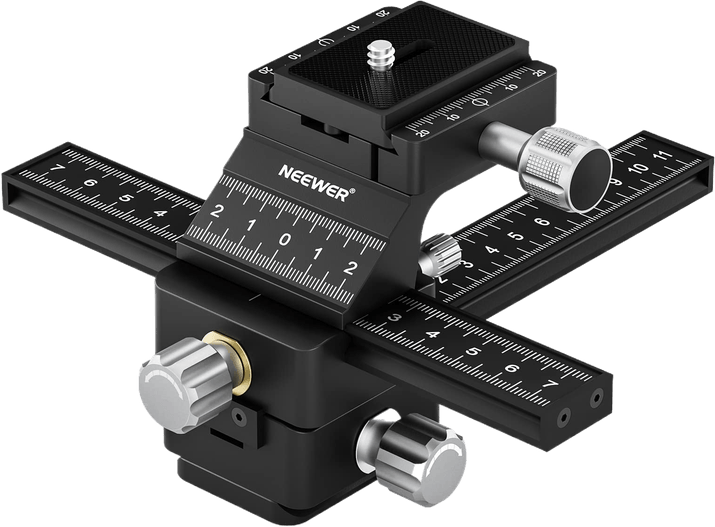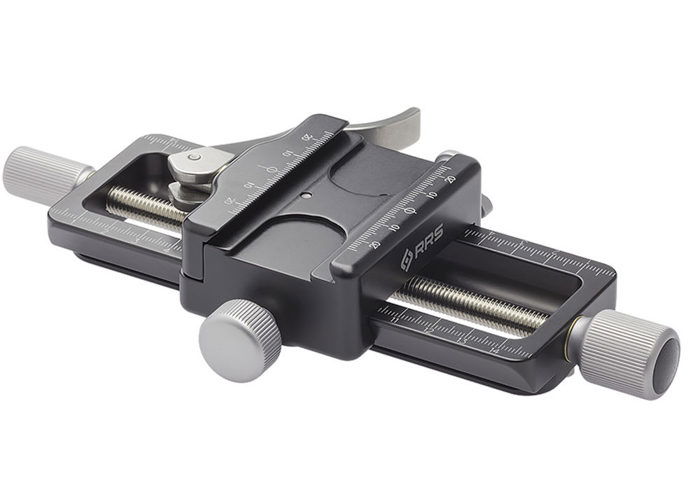A macro focusing rail is a great tool for shooting subjects up close. It keeps your camera still and lets you micro-adjust the focal point for perfect focus every time.
But it can do so much more for your macro photography, like image stacking. Continue reading to learn how you can use a macro focusing rail to take your macro photos to the next level.

A macro focusing rail is a system that lets you move your camera forward and backward or even left to right. It is necessary for capturing the best macro photographs for a few reasons.
For one, you can adjust your focus in tiny increments, which helps ensure a sharp focus. This is really handy since the depth of field tends to be very shallow in macro photography.
Macro photography requires the camera to get very close to objects, limiting your focal depth. This is great for bokeh and out-of-focus backgrounds. But if you’re looking to capture a subject entirely in focus, then you’ll need a focusing rail.
The mechanics of the macro focusing rail give you a precise focus. You can use multiple focal points across your image in a technique called focus stacking.
Focus stacking is when a photographer takes multiple shots of the same image, each with a different focal point. This allows the photographer to stitch many images together to create one in-focus image. This is done with editing software for photo stitching.
The number of images you need to take depends on how deep or shallow your depth of field is. A focusing rail has measurements that allow you to move it as much or as little as you want. These measurements allow you to take multiple shots in perfect increments.
A macro focusing rail allows you to keep your camera’s settings consistent. You don’t need to change the lens’ focusing barrel. The mechanics of the focusing rail do that for you.
Start by attaching your camera or lens to the macro focusing rail. You usually use the tripod thread on the bottom of your camera unless you are using a telephoto macro lens. A telephoto lens connects to the macro focusing ring via its tripod collar.
Once your camera is set up on the macro focusing rail, you need to choose your first focal point. Do you want to start from the back or front of the subject? Knowing your first focus point allows you to set up your camera in the right position on the focusing rail.
This macro rail works by twisting the knob to move the plate backward and forward. For example, if the tripod plate starts all the way at the back, it can only move forward. This would be a starting position for focusing on the front of the subject and moving toward the back.
How many images you need to take depends on your depth of field. This is itself determined by your aperture and distance from the subject. A shallower depth of field will require more images shot in smaller increments.
Similarly, the bigger the object, the more images you need to get the whole thing in focus. The images you capture will need to overlap slightly. This ensures there aren’t any focus gaps when you stitch them together.
Levon Biss, an insect macro photographer, captures images at 10-micron intervals. To put things in perspective, a human hair is around 75 microns thick! This is why he uses up to 10,000 images to create one in-focus image!
For most macro images, capturing between eight and 45 images at different focus points is enough.

Macro focusing is a technique for focusing on macro photography subjects. Macro photography is all about shooting tiny subjects and enlarging them to at least a 1:1 ratio.
Anything below this is a close-up image and not a true macro image. To achieve this, you need to know how to focus on each of the subjects you want to shoot. Insects are a common subject for macro photography due to their detail and interest.
Focusing on such a small subject can be troublesome. For starters, you need a dedicated macro lens or macro accessories like extension tubes or a macro bellows. These accessories allow you to use normal lenses for macro photography.
One thing that makes dedicated macro lenses different from other types of lenses is their close focusing distance. For example, the Canon EF 100mm f/2.8L IS USM Macro Lens has a closest focusing distance of 0.99 ft (0.3 m). The regular Canon EF 100mm f/2 USM Lens has a minimum focusing distance of 3 ft (0.9 m).
To ensure that your entire subject is in focus, it’s best to use a focusing rail. This allows you to make micro-adjustments of your focal point. You can then stitch them together for an image that is entirely in focus.

To achieve a true macro image, you need a few things. For starters, you need a lens that gives you a short minimum focusing distance. You can achieve this from specific macro photography lenses or by reversing a lens you already own.
You could also try freelensing. This means holding the lens without attaching it to the camera. A macro lens can be used alongside extenders, allowing you to close the gap between your lens and subject.
A tripod is necessary for keeping your camera as still as possible. This allows you to capture multiple images without changing the framing of the photo. If you focus stack your images, a tripod ensures each shot is exactly the same.
In terms of focusing, a macro focusing rail is helpful for focus stacking. Here, you have full control over how much you adjust your focal point and placement, using small increments if needed.
Lighting is important in keeping your shutter speed fast. This is especially helpful when capturing insects in motion, no matter how slow they may move.
If you don’t have ideal lighting conditions, you can add light in many ways. This includes everything from using a ring light to complicated macro flash setups.
When dealing with tiny subjects, tools such as tweezers are also important. They will help you move the object around without damaging it. They’re also easier to use for placing your subject exactly where you want it.
A macro focusing rail is a fantastic tool that can help you perfect your macro photography. Using one will ensure your camera focuses on the exact part of the subject you want in focus. And it’s the only way you can use focus stacking to take macro images with the entire subject in focus.

